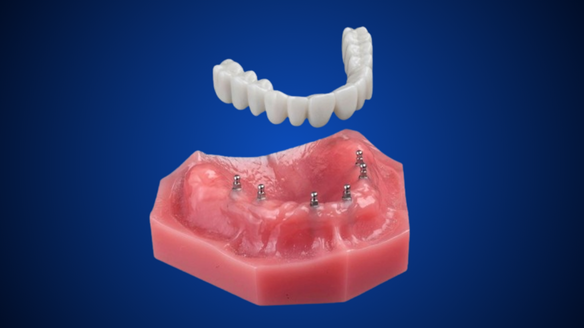Innovation has a way of reshaping our lives in ways we don’t always notice—until we pause to reflect on just how far we’ve come. It’s the quiet force that simplifies tasks, solves problems, and makes the extraordinary feel ordinary. Remember the days of unfolding maps or asking for directions? GPS didn’t just replace those moments; it redefined how we navigate the world. Progress like this often goes unnoticed because it becomes integral to our routines. In dentistry, progress is equally profound. Dentures, once a functional but imperfect solution, have evolved into transformative tools of restoration. The roundhouse bridge, supported by mini dental implants, is a shining example of this advancement. It provides stability, function, and beauty that were once thought unattainable, offering a lifelike solution that lets people reclaim their confidence and live fully.
These advancements show us that innovation isn’t simply about solving problems but transforming lives. And that’s the kind of progress we should never take for granted.
What Is a Roundhouse Bridge?
When you picture dentures, a familiar image likely comes to mind: a gum-colored base paired with artificial teeth designed to rest on the gums and restore function. Traditional dentures rely on adhesives, suction, or clasps to stay in place, but these methods often fail to provide lasting stability. They can shift, become uncomfortable, and require frequent maintenance—a solution, but not without its challenges.
So, how is a roundhouse bridge different? A roundhouse bridge is a horseshoe-shaped prosthetic designed to replace a full arch of teeth on the upper or lower jaw. Unlike traditional dentures, it does not have a large gum-colored base that covers the roof of your mouth or wraps thickly around the gums. Instead, the bridge is slimmer and follows the natural curve of your jawline, ensuring a more natural and comfortable fit. Its design eliminates the need for adhesives and removes the bulky palate cover found in upper dentures, allowing for a more open, unobtrusive feel.
The most significant difference lies in how the roundhouse bridge is secured. The roundhouse bridge is permanently anchored to dental implants Dr. Hall places in the jawbone. This creates a stable foundation that eliminates the need for adhesives and ensures the bridge won’t shift or slip. The result is a restoration that feels more like natural teeth—stable, reliable, and built to last.
Mini Dental Implants: The Support for Your Roundhouse Bridge
The foundation of a roundhouse bridge is much more than just a technical detail—it’s the key to its transformative power. Think of a house without a solid foundation; no matter how beautifully built, it won’t stand the test of time. Similarly, the roundhouse bridge depends on its support system with dental implants. However, the choice of implants to support a roundhouse bridge is just as important as the foundation itself.
Among the options available, mini dental implants offer unique benefits. Unlike traditional implants, typically around 5 millimeters wide, mini implants measure less than 3 millimeters in diameter. This smaller size introduces significant advantages, particularly for patients with reduced bone density—a common issue after tooth loss.
While traditional implants often require a strong, substantial bone structure for successful placement, mini implants can be placed in areas with less bone volume. This eliminates the need for extensive procedures like bone grafting, making the treatment more accessible and less invasive. For patients, this means a stable, secure foundation for their roundhouse bridge—even in cases where traditional implants might not have been an option.
The Benefits of Implant Dentures
If you’re leaning toward traditional dentures, it’s worth taking a moment to consider some essential health factors. One of the most impactful concerns revolves around a term no one wants to hear: denture face.
So, what is denture face? It’s the gradual change in facial appearance that can occur with traditional dentures, particularly ill-fitting ones. When teeth are lost, the surrounding alveolar bone begins to shrink—a process called resorption. The bone, no longer stimulated by the pressure of chewing or biting, essentially starts to disappear because the body assumes it’s no longer needed. Over time, this bone loss can lead to noticeable changes in facial structure:
- Sunken cheeks and a less defined jawline, giving the face a hollow, aged look.
- Sagging facial muscles and skin can develop, exaggerating the appearance of aging.
- Thinner lips and altered contours that diminish the natural fullness of your face.
While traditional dentures replace missing teeth, they sit on the gums and do nothing to stop the bone loss underneath. Implant dentures, like a roundhouse bridge, offer an advantage. Mini dental implants act like artificial tooth roots, securely anchoring the prosthetic and delivering the same type of stimulation to the jawbone that natural roots provide. This stimulation halts bone resorption, preserves the bone structure, and helps maintain facial shape and contours over time.
Discover a Stronger Foundation for a Healthier Smile
A roundhouse bridge supported by mini dental implants offers a secure, natural-feeling solution that restores more than just your teeth—it restores your confidence and preserves your health. Don’t let traditional options hold you back. Schedule a free consultation with Dr. Hall today and experience the difference modern dental innovation can make.
Follow us on Facebook and Instagram to see real patient transformations and the latest on implant denture solutions!

